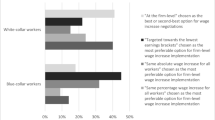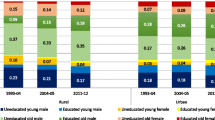Abstract
The OECD has repeatedly recommended that wage bargaining in Austria be decentralised to allow wage diferentials to widen. But the status quo itself is in question. While studies of aggregate industry data indicate a high degree of wage dispersion, research based on data from household surveys seems suggest that income inequality in Austria is as small as in the Scandinavian countries. This paper seeks to reconcile these opposing views. It shows that data from the household surveys underestimate the size of inter-industry wage differentials. An analysis of the structure of contractual wage rates supports the view that wage inequality is very pronounced in Austria and that a narrowing of the wage gap would lead both to an increase in productive efficiency and an increase in income equality.

Similar content being viewed by others
Notes
For Austria, these data refer to the large-scale manufacturing sector (Industrie as opposed to Gewerbe, see Sect. 4 for a discussion of this distinction).
A rising trend in wage dispersion in manufacturing in Austria was also found in studies of the cyclical behaviour of the wage structure; the increase in wage inequality was only interrupted in periods of cyclical peaks and at times when the share of foreign workers in Austria's employment dropped sharply (Pollan 1980, 2004).
See also Zweimüller (1992).
In some years the income data even included children's allowances.
In the ISSP-1987/ISSP-1988 Survey, 26% of the respondents refused to answer the income question (or had no income at all). On the industry classification, see Sect. 4.
Contractual wage rates (Kollektivvertragslöhne or Tariflöhne), arrived at in settlements between the unions and the employers, are also sometimes referred to as negotiated or basic wage rates. In this context, these terms also cover contractual salary rates of white-collar workers
Austria does not have minimum wage legislation that provides for a minimum wage for the whole economy. Rather the contractual wage rate for the least skilled group of workers constitutes the de facto minimum wage rate for the industry covered by the collective wage contract.
Rough calculations show that 20–25% of employees in the private sector (mostly in large-scale manufacturing and construction, the financial sector, the (formerly state-owned) postal service and federal railways) can be allocated to the high-pay sector, and 70–75% to the low-pay sector (mainly in the small-scale industry and crafts sector, and the service sector). About 6% of employees in the private sector are not covered by collective agreements (Bönisch 2008). About 2.7 million persons are employed in the private sector.
After a merger in 2006, the union is now called the Union of Salaried Private Sector Employees, Printing, Journalism and Paper.
Biffl (2002), on the basis of a different data set, shows that this conclusion holds with regard to wages and salaries for all qualification levels.
For details see Pollan (2000, pp. 51–57).
Part of the misspecification problems concerning the improper industry classification may be alleviated by introducing dummy variables for the firm size, as, in general, businesses in the Industrie section are larger than businesses in the Gewerbe section. But this step raises the question as to the final determinants of the bargaining structure and of the institutional setup in general, a topic outside the scope of this paper. At a more practical level, it is not always the case that firms in the Industrie section are larger than firms in the Gewerbe section: some businesses in the food industry, though classified as Gewerbe (with lower wage rates), are larger than businesses classified as Industrie.
For a review of these recommendations, see OECD (2004).
Austria's position in the centralisation/co-ordination rankings, the other salient feature of such international comparisons, has also been questioned (Pollan 2004).
Similar criticisms apply to the use of data from the International Social Survey Programme.
However, the empirical evidence hardly allow us to rule out the efficiency wage hypothesis completely: the characteristics of industries likely to pay higher wages for efficiency reasons seem to overlap with those of firms likely to have powerful works councils, to obtain protection from competition and to be candidates for state ownership, but this topic is beyond the scope of this paper.
References
Arpaia A, Mourre G (2005) Labour market institutions and labour market performance: a survey of the literature. European Commission Economic Paper 238
Atkinson A, Brandolini A (2001) Promise and pitfalls in the use of “secondary” data sets: income inequality in OECD countries as a case study. J Econ Lit 39:771–799
Barth E, Zweimüller J (1992) Labour market institutions and the industry wage distribution, evidence from Austria, Norway and the US. Empirica 19(2):181–201
Biffl G (2002) Die Kosten des österreichischen Bildungssystems und der Wert der Ausbildung. WIFO Monatsberichte 75(6):385–395
Björklund A, Bratsberg B, Erikson T, Jäntti M, Raaum O (2007) Inter-industry wage differentials and unobserved ability: siblings evidence from five countries. Ind Relat 46(1):171–202
Blau FD, Kahn LM (2003) Understanding international differences in the gender pay gap. J Labor Econ 21(1):106–144
Bönisch M (2008) Kollektivvertragliche Abdeckung in Österreich. Stat Nachr 3:207–211
Dickens W, Katz L (1987) Inter-industry wage differences and industry characteristics. In: Lang K, Leonard J (eds) Unemployment and the structure of labor markets. Basil Blackwell, London, pp 48–89
Flanagan R (1987) Efficiency and equality in Swedish labor markets. In: Bosworth B, Rivlin A (eds) The Swedish economy. Brookings Institution, Washington
Förster M, d’Ercole M (2005) Income distribution and poverty in OECD countries in the second half of the 1990s. OECD Social Employment and Migration Working Papers 22, OECD, Paris
Förster M, Pearson M (2002) Income distribution and poverty in the OECD area: trends and driving forces. OECD Econ Stud 34:1
Freeman RB (1988) Labour market institutions and economic performance. Econ Policy 6:64–80
Freeman RB (2005) Labour market institutions without blinders: the debate over flexibility and labour market performance. Working Paper 11286, NBER, Cambridge
Gannon B, Plasman R, Rycx F, Tojerow I (2007) Inter-industry wage differentials and the gender wage gap: evidence from European countries. Econ Soc Rev 38(1):135–155
Guger A (1987a) Arbeitskosten und Produktivität als Determinanten der kostenbestimmten Wettbewerbsfähigkeit der österreichischen Industrie. In: Österreichische Strukturberichtserstattung, Kernbericht 1986, Band II, Austrian Institute of Economic Research, Vienna
Guger A (1987b) Der Einfluß der Staatstätigkeit auf die ‘Wohlstandsverteilung. Von der Primär- zur Sekundärverteilung. In: Guger A (ed) Umverteilung durch öffentlichen Haushalte in Österreich. Austrian Institute of Economic Research, Vienna, pp 3–60
Guger A (1991) Arbeitskosten nach Branchen deutlich differenziert. WIFO Monatsberichte 65(10):571–576
Guger A (1996) Umverteilung durch Steuern und Abgaben. In: Guger A (ed) Umverteilung durch öffentliche Haushalte in Österreich. Austrian Institute of Economic Research, Vienna, pp 20–36
Hartog J, Pereira PT, Vieira JAC (2000) Interindustry wage dispesion in Portugal. Empirica 27:353–364
Hedström P, Swedberg R (1985) The power of working class organizations and the inter-industrial wage-structure. Int J Com Sociol 26:90–99
Hibbs D, Locking H (2000) Wage dispersion and productive efficiency: evidence for Sweden. J Labor Econ 18(4):755–782
Hofer H (1992) Eine Untersuchung über die Ursachen der sektoralen Lohnunterschiede in Österreich. Forschungsbericht 311. Institute for Advanced Studies, Vienna
Kahn LM (1998) Collective bargaining and the interindustry wage structure: international evidence. Economica 65:507–534
Kahn LM (2000) Wage inequality, collective bargaining, and relative employment from 1985 to 1994: evidence from fifteen OECD countries. Rev Econ Stat 82(4):564–579
Katz L, Summers L (1989) Industry rents: evidence and implications. Brookings Pap Econ Act: Microecon 1989:209–290 [Special Issue]
Kronsteiner C, Wolf W (1994) Personen- und Haushaltseinkommen der unselbständig Beschäftigten 1993. Stat Nachr 12:994–1003
Krueger A, Summers L (1988) Efficiency wages and the inter-industry wage structure. Econometrica 56(2):259–293
Martins P, Pereira P (2000) Does education reduce wage inequality? Quantile regressions. Evidence from Fifteen European Countries. IZA Discussion Paper 120
Milanovic B (2002) True world income distribution, 1988 and 1993: first calculation based on household surveys alone. Econ J 112:51–92
Moene K, Wallerstein M (1997) Pay inequality. J Labor Econ 15(3):403–430
OECD (1994) The OECD jobs study: facts, analysis, strategy. OECD, Paris
OECD (1997) OECD country report: Austria. OECD, Paris
OECD (1999) Implementing the OECD jobs strategy: assessing performance and policy. OECD, Paris
OECD (2001) OECD country reports: Austria. OECD, Paris
OECD (2004) Wage-setting institutions and outcomes. OECD employment outlook, Chap. 3. OECD, Paris
Österreichischer Gewerkschaftsbund (1999) ÖGB-Kurzbericht 1995–1998. Verlag des ÖGB, Vienna
Pollan W (1997a) Grosse Lohnunterschied nach Branchen in der Industrie. WIFO Monatsberichte 70(3):171–178
Pollan W (1997b) Political exchange in Austria’s collective bargaining system: the role of the nationalized industries. In: Sverke M (ed) The future of trade unionism. Ashgate, Aldershot
Pollan W (1980) Wage rigidity and the structure of the Austrian manufacturing industry—an econometric analysis of relative wages. Weltwirtschaftliches Archiv 116(4):697–728
Pollan W (2000) Einige Aspekte der Lohnbildung in Österreich. Lohnunterschiede und die Zentralisierung der Lohnverhandlungen. Austrian Institute of Economic Research, Vienna
Pollan W (2004) Austrian exceptionalism. Labour market institutions and wage disparity. Austrian Institute of Economic Research, Vienna
Pollan W (2005) How large are wage differentials in Austria? Working Paper 265, Austrian Institute of Economic Research, Vienna
Pollan W, Leoni T (2003) Die Einkommensunterschiede nach Wirtschaftsbranchen in Österreich. Ein Vergleich zwischen Mikrozensus und Leistungs- und Strukturerhebung. WIFO Monatsberichte 76(12):901–909
Rowthorn R (1992) Corporatism and labour market performance. In: Pekkarinen J, Pohjola M, Rowthorn R (eds) Social corporatism. Clarendon Press, Oxford, pp 44–81
Rycx F, Tojerow I (2007) Inter-industry wage differentials: what do we know? Reflets et Perspectives de la vie économique XLVI(2/3):13–22
Statistics Austria (2004) Ausgewählte Kollektivvertragslöhne, 31. Dezember 2003, Vienna
Teulings C, Hartog J (1998) Corporatism or competition? Labour contracts, institutions and wage structure in international comparison. Cambridge University Press, Cambridge
Walterskirchen E (1987) Lohnunterschiede nach Betrieben und Branchen. WIFO Monatsberichte 60(8):492–497
Windmuller J (1987) Comparative study of methods and practices. In: Windmuller J et al (eds) Collective bargaining in industrialized market economies: a reappraisal. International Labour Organisation, Geneva
Wolf I, Wolf W (1991) Wieviel weniger? Einkommensunterschiede zwischen Frauen und Männern in Österreich. Bundesministerium für Arbeit und Soziales, Wien
Zweimüller J (1992) Survey non-response and biases in wage regressions. Econ Lett 39:105–109
Zweimüller J, Barth E (1994) Bargaining structure, wage determination, and wage dispersion in six OECD countries. Kyklos 47(1):81–93
Author information
Authors and Affiliations
Corresponding author
Rights and permissions
About this article
Cite this article
Pollan, W. How large are wage differentials in Austria?. Empirica 36, 389–406 (2009). https://doi.org/10.1007/s10663-008-9099-7
Published:
Issue Date:
DOI: https://doi.org/10.1007/s10663-008-9099-7
Keywords
- Wage differentials
- Wage structure
- Income inequality
- Decentralised wage setting system
- Collective bargaining




